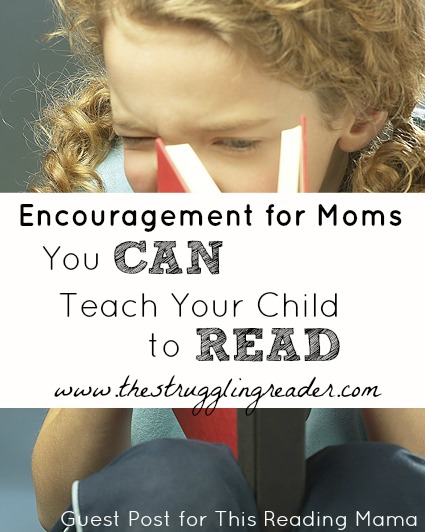This post contains affiliate links. Please read my full disclosure policy for more information.

One of the amazing vendors I met at Teach Them Diligently last year was Bill and Kristen Eckenwiler from The Struggling Reader. I am honored today to have Kristen guest posting as she encourages those tired and weary moms of struggling readers…You CAN Teach your Child to READ.
____________________________________________________________________________________
I remember the day when my oldest child slid on his shoes and walked funny to the door. “Why are you walking that way?” I inquired. “I don’t know,” said my sweet boy. Well, how many of us have never thought about our children’s feet growing until their shoes are to small? I think he was 7 years old then…in a size 3! I made a mental note so many years ago that at age 7, I needed to take my younger child for shoes….he would be a size 3.
Learn to Be Flexible
That made parenting easy then. I just noted the age and shoe size of the oldest and that dictated my every shoe size from then on. Really? Of course not. We cannot dictate the size of our children’s feet any more than we can decide when they will walk or speak their first word. Why then, I must ask, do we expect our children’s brains and educational development to reach certain “bench-marks” at the same time?
When you set out to teach your child to read, the best piece of advice I can offer is to train your mind, not theirs, to understand that you are teaching a specific child, a “one and only,” DNA all to themselves human being. All children have their own set of gift and talents. Some things will come easier than others.
Reading is very complex. As a specialist, I look and look at many specifics in reading for challenges, and it is amazing how some children can simply sit with you a few times and watch you read. All they have to do is look at the words and “WHAM” they are readers. They just “get it.” While other children will labor for years and struggle.
As a Reading Specialist and a homeschool mom, I have worked with so many children that struggled, even in my own home. I have certainly learned to take deep breaths and now I try to encourage Mom-teachers in all of my travels to do the same. Even children with severe learning challenges can and do learn to read. Realize that the gift of teaching your own child at home is the best possible scenario. See each child as an individual and embrace their strengths and weaknesses. Learning to read is not a race.
A Multi-Modality Approach to Reading
You be the expert! There is so much available to homeschool families now to teach reading. Many of your children will thrive with a workbook type approach, some will enjoy more color and activity, while others will labor in that kind of approach. Research has proven over and over that a multi-modality approach to learning is best. If you have a child that labors with a challenge, seems to be struggling, or just cannot sit still, look for curriculum that will lend itself to movement, sound, visuals and touch modalities. What works for one of your children {or four of them} may not work for all of them. Be open to change. It is hardest on you!
The 5 Key Areas of Reading
The National Reading Panel determined years ago that there are key areas in reading that should be focused on when teaching this skill. Be sure that you understand them and find them in the material you are using, especially if you have a struggling reader! They are:
- Phonemic Awareness: The ability to process the auditory sounds in our language. This is NOT phonics! There is NO letter sound identification. (Think pictures or sounds only, not text.)
- Phonics: Understanding the “code” of our language, letter and letter combinations and their sounds and the exceptions as well.
- Fluency: Reading with rhythm and voice inflection that follows meaning and purpose in words. This includes recognizing sight words which are the most common words in print.
- Vocabulary: Understanding the use of words and applying meaning to the language in context.
- Comprehension: Applies to all reading…fiction, non-fiction, maps, recipes…what is the author giving me that I need to formulate understanding?
Never lose patience with a new or struggling reader. Expect to often times take three steps forward and two steps back. Some days you will tread water, some days you will catapult and others will be backward steps. Always guard your relationship with your child. The reading will come. They are in the best possible place to learn: with you!
Kristen and her husband, Dr. William Eckenwiler, are both reading specialists. Together, they co-founded The Struggling Reader in an attempt to come alongside parents and teachers in their efforts to help children who are struggling in this area. You can read more about Kristen and her husband at www.TheStrugglingReader.com Mention this blog post to receive 20% off any order.
Oh, I wish I had read this 5 years ago. It would have helped me so much. These are lessons I have learned the hard way. Thank you for reaching out and equipping homeschool Moms.
thanks for outlining the basics in very understandable language for parents. I work in autism and children who have been through early life traumatic experiences (foster care, over seas ophanage) The struggle many of these children have in the reading process overwhelms them and their parents. Very helpful post.